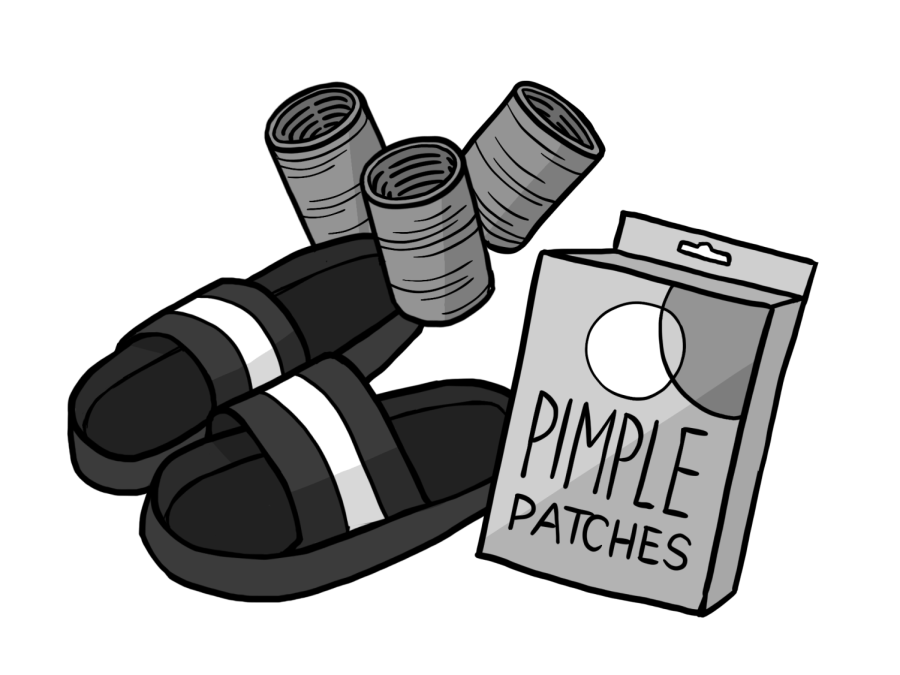A&E: Pimple patches, pajamas and pull-overs: students partake in ‘dressing down’
Over the years, a manicured image at school from formal outfits has shifted to dressing down in pajama pants, hair curlers and pimple patches. A line between busy and lazy, the SCHS community reflected on the norm for casual dress code at high school.
For sophomore Stephanie Padilla, wearing what makes her feel comfortable and safe is her preferred style. Padilla noticed the normalization of students donning pimple patches and hair curlers at school and attributed its popularity to the rise of aesthetics.
“I think the idea of aesthetics has contributed to these looks becoming more normal,” Padilla said. “Most people do it because they do have pimples that they want to cover on their faces, or they just want their hair to be undone at school.”
Senior Amanda Weinger found it unique that students are enjoying a casual style. She compared current trends of dressing to ones from older generations.
“I know that back in our parents’ generation, that (casual wear) was considered kind of a no-no. I feel like going out of the house with a roller in your hair was seen as super undone and not professional,” Weinger said. “Now that people our age are able to feel comfortable doing that, it’s kind of an improvement in society in a way.”
Horizons teacher Hao Pham grew up in the 1980s, where cliques such as jocks, skaters and geeks existed. Pham reflected on current social and environmental influences on students.
“When talking about students, they can be influenced by a variety of media and everything else. However, the immediate influence is their teachers,” Pham said. “Myself and others, sometimes we had staff that when I grew up, they would actually dress up. Sometimes when we have staff that dresses more casually, that could affect students.”
Pham believes the lenient dress code affects student learning depending on the individual’s habits and maturity.
“From my professional viewpoint, it can be beneficial as long as students are being responsible, whether it be academically, socially or emotionally. That’s how I would measure that in a sense,” Pham said. “If the clothing they dress down in has certain logos and brands is impacting our population, our students and our learning in some negative way, then it’s not beneficial.”
Junior Michell Torres finds that a lot of his friends’ wardrobe consists of pajama pants and fuzzy slippers. He shared that the change to casual wear has surfaced from a laidback dress code.
“It’s really noticeable that things like that (casual wear) are becoming more normalized since all my friends do it,” Torres said. “I think this culture has grown partly because of the free dress. You can wear a lot of things, so why not wear what you wore to bed.”
Similarly, Padilla thinks relaxed outfits should be accepted among students. She finds that having freedom of choice in clothing has been beneficial.
“It should be normalized because I don’t see why people should judge other people for wearing what they like,” Padilla said. “Dressing down has really helped me learn better because I’m learning in clothing that makes me feel comfortable.”
After attending a Catholic school for nine years, Weinger appreciates the opportunity to dress freely and not be restricted by a dress code.
“I was forced to wear a pleated plaid skirt that had to fall below the knee and wear collared shirts,” Weinger said. “Coming here and being able to dress how I want without feeling restricted was really empowering in a way that helped me develop my own style.”
For Torres, a lack of time in the morning can contribute to a growing scene of casual wear among the student body.
“Another major thing that comes to mind is wanting to get more time in bed,” Torres said. “A friend of mine comes in with pajamas half of the time because they always wake up so late. You’re already in those clothes, might as well go to school in them.”
Weinger believes it is important for students to openly express themselves through their styles without feeling restricted.
“I think the way you dress is how people initially perceive you,” Weinger said. “Dressing how you want is like a snapshot into your personality and who you are as a person.”


